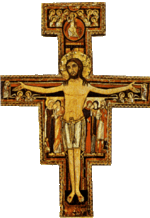Chaldean Catholic Church
| Part of the series on Eastern Christianity |
|
 Eastern Christianity Portal |
|
|
History |
|
|
Traditions |
|
|
Liturgy and Worship |
|
|
Theology |
|
The Chaldean Catholic Church or the Chaldean Church of Babylon (Arabic: الكنيسة الكلدانية, al-kanīsä 'l-kaldāniyyä) is an Eastern particular church of the Catholic Church, maintaining full communion with the Bishop of Rome and the rest of the Catholic Church. The Chaldean Catholic Church presently comprises an estimated 600,000 - 700,000 Chaldean Christians.[1]
Contents |
History
The Chaldean Church descends from the Church of the East: After the massacres of Tamerlane around 1400 had devastated several bishoprics, Patriarch Shimun IV (1437-1493) made the office hereditary within his own family[2] Dissent over this practice grew until in 1552 a group of bishops refused to accept the hereditary succession of Shimun VII Ishuyau bar Mama (1539-1558).[2]
They elected Mar Yohanan Sulaqa, the superior of the Rabban Hormizd monastery 30 miles (48 km) north of Nineveh as a rival Patriarch. With the help of the Latin missionaries Sulaqa travelled to Rome and met with the Pope, eventually entering into communion with the Catholic Church. On February 20 1553 he was proclaimed as the patriarch of "Mosul and Athur" (Assyria) by Pope Julius III.[3] The Chronicle of the Carmelites states that Sulagga was proclaimed "Patriarch of the Eastern Assyrians" but on April 19 1553 the title was changed to "Patriarch of the Chaldeans",[4] to distinguish his group from the Assyrian church[1] and perhaps in reference to the Old Testament, which gives Abraham's birth place as "Ur of Chaldee".
In 1662, Patriarch Mar Simon XIII Dinkha, broke communion with Rome and moved his seat from Diyarbakır to the village of Qochanis in the Turkish mountains. The Holy See responded by appointing a new patriarch to Diyarbakır to govern the Chaldeans who stayed loyal to the Holy See. This group became known as the Chaldean Catholic Church.
Starting in the mid-18th century the Assyrians of the Plain of Nineveh were gradually converted to Catholicism by the Latin Missionaries. Their communion with Rome was finalized in July 1830, when Pope Pius VIII confirmed John Hormizd, patriarch of the Church of the East, who had been instrumental in spreading Catholic faith among his people, as the new Patriarch of the Chaldean Church.[5]
The most recent development in the Chaldean Rite of the Catholic Church has been the creation of the Eparchy of Oceania, with the title of 'St Thomas the Apostle of Sydney of the Chaldeans'. This jurisdiction includes the Chaldean Catholic communities of Australia and New Zealand, and the first Bishop, named by Pope Benedict XVI on 21st October 2006, is Archbishop Djibrail Kassab, until this date, Archbishop of Bassorah in Iraq. The church's relations with the Assyrian Church of the East have improved in recent years. A meeting in 1996 between H.H Mar Dinkha IV of the Assyrian Church and Mar Raphael I Bidawad of the Chaldean Catholic Church began an effort to bring the two churches into eventual communion.
The current Patriarch is Cardinal Mar Emmanuel III Delly, elected in 2003 on the death of Mar Bidawid. In October 2007 Delly became the first Chaldean Catholic to be elevated to the rank of Cardinal within the Catholic Church. [6]
There has been a large immigration to the United States particularly to Southeast Michigan. There is also a population in parts of California and Arizona. Several thousands are stranded in passage [7]. The church's most infamous member was Saddam Hussein's foreign minister, Tariq Aziz.
Hierarchy
|
|||||||||||||||||
Chaldean-Assyrian Catholic Church in Iran
Eastern Catholicism |
|
|---|---|
| Syro-Malabar Church | |
| Chaldean Catholic Church | |
| Coptic Catholic Church | |
| Ethiopian Catholic Church | |
| Maronite Church | |
| Syriac Catholic Church | |
| Syro-Malankara Catholic Church | |
| Armenian Catholic Church | |
| Albanian Greek-Catholic Church | |
| Belarusian Greek Catholic Church | |
| Bulgarian Greek Catholic Church | |
| Croatian Greek Catholic Church | |
| Greek Byzantine Catholic Church | |
| Hungarian Greek Catholic Church | |
| Italo-Albanian Catholic Church | |
| Macedonian Greek Catholic Church | |
| Melkite Greek Catholic Church | |
| Romanian-Greek-Catholic | |
| Russian Byzantine Catholic Church | |
| Ruthenian Catholic Church | |
| Slovak Greek Catholic Church | |
| Ukrainian Greek Catholic Church | |
| Full list • Eastern Catholicism | |
- Diocese of Sanandaj
- Archdiocese of Tehran
- Archdiocese of Urmih
- Archdiocese of Ahwaz
Chaldean Christian Martyrs
- Fr. Ragheed Aziz Ganni, with subdeacons Basman Yousef Daud, Wahid Hanna Isho, and Gassan Isam Bidawed, 3 June 2007, Mosul, Iraq.
- Archbishop Paulos Faraj Rahho and three companions, 29 February 2008, Mosul, Iraq.
See also
- Eastern Catholicism
- Eastern Orthodoxy
- Liturgies: East Syrian Rite, Holy Qurbana of Addai and Mari
- Byzantine Discalced Carmelites
External links
- Chaldean Catholic Church - from the website of the Catholic Near East Welfare Association.
- Chaldean Catholic Diocese of Saint Peter
- Catholic Churches (In German)
- East Syrian Rite (Catholic Encyclopedia)
- History of the Chaldean Church
References
- ↑ 1.0 1.1 Who Are the Christians in the Middle East? - Page 163 by J. Martin Bailey, Betty Jane Bailey
- ↑ 2.0 2.1 Chaldean Catholic Church (Eastern Catholic), The newCatholic Encyclopedia, The Catholic University of America, Vol. 3, 2003 p. 366.
- ↑ Xavier Koodapuzha, "Faith and Communion in the Indian Church of Saint Thomas Christians, Oriental Institute of Religious Studies, Kerala, India, p.59
- ↑ George V. Yana (Bebla), "Myth vs. Reality" JAA Studies, Vol. XIV, No. 1, 2000 p. 80
- ↑ Catholic Encyclopedia Vol.3 p. 368
- ↑ AP
- ↑ Iraq's Christians on the run (in German)
|
|||||||||||||||||||
|
|||||||||||||||||||||||||||||||||||||||||||||

